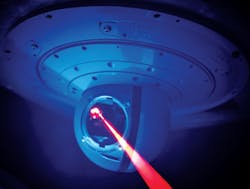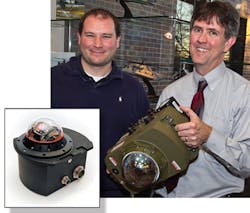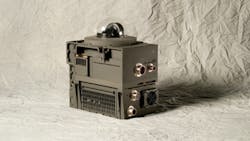Photonic Frontiers: Laser Countermeasures: Scaling down mid-IR laser countermeasures for smaller aircraft

Mid-infrared (mid-IR) laser sources earned a niche in the world of military countermeasures in the 1990s by showing they could prevent heat-seeking missiles based on mid-IR detectors from homing in on the thermal signatures of aircraft engines. Since then, they have been deployed on hundreds of large fixed-wing and rotary military aircraft. However, those systems weigh several hundred kilograms, making them too heavy as well as too costly for use on smaller aircraft.
Now, a triservice military program is developing a new generation of smaller and less expensive IR countermeasure systems to fill that gap. The Common InfraRed CounterMeasures (CIRCM) program is important enough to be listed as a line item in the Pentagon's research, development, test, and engineering budget. Serious funding began with nearly $100 million in fiscal 2013, and $120 million is slated for fiscal 2014. BAE Systems' Electronic Systems group (Nashua, NH) and Northrop Grumman's Electronic Systems group (Rolling Meadows, IL) have developed competing designs, and down-selection is to begin later in 2014. The winner will produce an initial run reported to be more than 1000 units under a contract expected to exceed $1 billion.1 Meanwhile, research labs are working on a newer generation of mid-IR lasers that might be used in future systems.
A technology arms race
The development of IR countermeasures inevitably followed the introduction of heat-seeking missiles in the 1970s. The first countermeasures were bright thermal flares fired from the aircraft to decoy the missiles away from the plane's hot engines. Missile developers responded with smarter mid-IR sensors, leading to development of the Directed InfraRed CounterMeasure (DIRCM) system, which focused light from a bright lamp with a parabolic mirror at the missile, modulating its output to fool the improved sensors.
The next generation of even smarter mid-IR guidance systems prompted development in the 1990s of upgraded DIRCM systems with smarter tunable light sources based on optical parametric oscillators (OPOs). One system, called LAIRCM, for large-aircraft IRCM, was first deployed in the 2000s, and has been installed in hundreds of aircraft, including Air Force C-5, C-17, and C-130 transports and Navy CH-46 and -53 helicopters. It relies on information from a missile warning system that detects and tracks solid-state missiles by observing the ultraviolet (UV) light from their hot exhaust. A gimbal system with a full 360° pivoting system then points the modulated countermeasure beam at the missile. Northrop Grumman's Guardian model, designed for installation on existing aircraft, packages all components into a 550 kg pod mounted under the aircraft—Fig. 1 shows the beam-directing turret. The company says the autonomous system can detect and jam an attacking missile in 2–5 s, without help from the aircraft pilot or crew.
BAE Systems has a similar system, the AN/ALQ-212 Advanced Threat Infrared Countermeasures (ATIRCM) system, also based on an OPO. It can be used on everything from light helicopters to fixed-wing aircraft, says Murray Collette, technical director at BAE Systems.
An OPO may seem an odd choice for a military system, but suitable laser sources in the 1–2 and 3–5 μm bands used by heat-seeking missiles were few and far between when LAIRCM systems were developed. "OPOs were the only laser technology that could emit the right mid-IR light at power levels that were effective and in packages that could meet ruggedization requirements for military aircraft," says Eric Takeuchi, director of business development at Daylight Solutions (San Diego, CA). The countermeasure system must deliver watts of modulatable mid-IR light that can be tuned to multiple wavelengths. OPOs also can deliver very high peak powers—important for flash-blinding missiles so they lose their lock on the steady IR glow from the plane's engine, says Collette. Then, the laser goes dark so the missile can't home in on the jammer.
The most crucial requirement was being compact and rugged enough to operate reliably in military aircraft. Frequency-doubled carbon-dioxide (CO2) lasers came close to the desired wavelength and power, but failed the durability test. OPOs passed and became the basis of currently deployed countermeasures.
New systems for smaller aircraft
The CIRCM program is intended to spread deployment of laser countermeasures to smaller aircraft and helicopters deployed in areas where shoulder-launched heat-seeking missiles (often called MANPADs) have become readily available. These slow-moving craft are easy targets but are too small to carry a heavy countermeasure system, so they need a new generation of countermeasure technology.
Size, weight, and power are driving factors for CIRCM, and Daylight Solutions is pushing quantum cascade lasers (QCLs) as the best technology for meeting system requirements.2 "Our perspective is that it's hard to beat a semiconductor; you can't get any simpler than turning electrons into photons," says Takeuchi. QCL powers are highest in the 3–5 μm countermeasure band, and they can be pulsed and tuned in wavelength to foil advanced heat-seeking sensors. Daylight says its multiwatt, multiwavelength QCL module called Solaris "provides fast, simultaneous breaklock jamming with high power in multiple colors to defeat current and future threats." Northrop Grumman is using it in its CIRCM system, shown in Fig. 2.Power efficiency is another QCL attraction for small aircraft with limited power resources. Pranalytica (Santa Monica, CA) in 2012 reported wallplug efficiency of 16.3% for a 4.7 μm QCL generating 4 W near room temperature.3 Reliability is crucial for military operation in hostile environments, and Daylight Solutions reports that performance of its Solaris module was validated by thousands of hours of environmental testing and end-to-end system tests for "all-weather, all-altitude operation."
However, BAE Systems is sticking with OPOs based on nonlinear crystals of zinc germanium phosphide (ZGP; see Fig. 3). "We like the OPO because it's a field-proven, low-risk technology now. The high peak power we get out of it is addressing requirements today and it has flexibility to address threats of tomorrow," says Collette. The company uses ZGP as the nonlinear crystal.At least three companies outside the U.S. offer laser countermeasure systems. Elbit Systems Electro-Optics (Rehovot, Israel) has a 40 kg multi-spectral infrared countermeasure (MUSIC) system that draws 1200 W of power and has introduced a 19 kg "mini" Music for use on military helicopters.4 Silex ES (Edinburgh, Scotland) offers a countermeasure system that weighs under 50 kg and draws only 500 W, but declined to provide details on the technology. Indra (Madrid, Spain) has a laser countermeasure system it claims can defeat simultaneous attacks by several missiles using more than 30 IR lines.
Airliner defense systems on hold
In the early 2000s, Congress asked the Department of Homeland Security (DHS) to develop laser countermeasures to protect large civilian airliners from attack by terrorists with MANPADS. In 2004, DHS awarded a pair of $45 million, 18-month contracts to BAE and Northrop Grumman to adapt military DIRCM systems for airliners. The proposal drew considerable interest at the time.5
Tests continued for a few years. BAE put its system on passenger jets flying between New York and California to study its effects on commercial airliners. "The technology is ready now," says Collette, but when Homeland Security reported to Congress, neither the government nor the airline industry were willing to foot the bill. The present danger from missile attacks in the U.S. is considered minimal, but a recent editorial in Aviation Week warned that could increase with more MANPADS in terrorist hands.6
DHS examined military systems, and BAE adapted its ATIRCM system for use in civilian airliners, flying it on commercial planes between JFK airport in New York and SFO and LAX airports on the West Coast. But development stalled out because neither Congress nor the airlines wanted to pay for the system.
Future laser technology
Meanwhile, researchers are investigating new laser technology for future generations of countermeasures. The growing interest in laser countermeasures has encouraged development of new mid-IR emitters that offer power, durability, and efficiency.
One evolutionary step is pumping an OPO with a 2.09 μm holmium-YAG laser, which at a 100 kHz repetition rate yielded average power to 7.7 W at 3–5 μm in tests at the French-German Research Institute (Saint-Louis, France). The group also has developed a "destruction laser" firing 82 mJ pulses at 100 Hz and is considering supercontinuum countermeasure sources.7 NP Photonics has produced 1.2 W of supercontinuum spanning 1 to 5 μm by pumping a nonlinear tellurite glass fiber with a 2 W source, including significant power at wavelengths longer than 4 μm.8
Iron-doped zinc selenide/sulfide is a solid-state laser that has attracted attention for countermeasures because it is tunable from 3 to 8 μm, but power has been limited by the pump sources available in its 2.6-3.1 μm absorption band. Pulsed optical pumping has reached 32% efficiency, with output to 0.5 J.9 Development of high-power quantum-well (AlGaIn)(AsSb) diode lasers at 2.9 μm could lead to the needed pump source.10
Those technologies are likely years away. The big question in the near term is whether the Pentagon will pick the tried-and-true OPO approach or the new and promising QCL in its down-selection for CIRCM.
REFERENCES
1. J. Keller, "Army ready to move laser-based aircraft missile countermeasures to full-scale development," Military & Aerospace Electronics, 25, 1, 31 (Jan. 2014); see http://bit.ly/NDKqYO.
2. T. Day et al., "Quantum cascade lasers for defense & security," Proc. SPIE, 8898, 889802 (Oct. 29, 2013); doi:10.1117/12.2031536.
3. A. Lyakh et al., Opt. Exp., 20, 4, 4382–4387 (2012).
4. T. Kington, "Competition over DIRCMs heats up," Defense News, see http://bit.ly/1csvm6n (Sep. 14, 2013).
5. J. Hecht, "Homeland Security broadens search for technology to protect planes," Laser Focus World, 42, 9, 97–100 (Sept. 2006); see http://bit.ly/1d3aWnP.
6. R. Ehrenfeld, "Protect airliners from SAM threat," Aviation Week & Space Technology, 58 (Feb. 17, 2014).
7. C. Kieleck et al., "Compact high-power/high-energy 2 μm and mid-infrared laser sources for OCM," Proc. SPIE, 8898, 889809 (Oct. 15, 2013); doi:10.1117/12.2031662.
8. R. Thapa et al., "Mid-IR supercontinuum generation in ultra-low loss, dispersion-zero shifted tellurite glass fiber with extended coverage beyond 4.5 μm," Proc. SPIE, 8898, 889808 (Oct. 15, 2013); doi:10.1117/12.2033926.
9. V. V. Fedorov et al., "Fe-doped II-VI mid-infrared laser materials for the 3 to 8 μm region," CLEO 2013 Technical Digest, JM4K2 (2013).
10. S. Hilzensauer et al., "High-power diode lasers between 1.8 μm and 3.0 μm for military applications," Proc. SPIE, 8898, 88980U (Oct. 15, 2013); doi:10.1117/12.2028745.
About the Author
Jeff Hecht
Contributing Editor
Jeff Hecht is a regular contributing editor to Laser Focus World and has been covering the laser industry for 35 years. A prolific book author, Jeff's published works include “Understanding Fiber Optics,” “Understanding Lasers,” “The Laser Guidebook,” and “Beam Weapons: The Next Arms Race.” He also has written books on the histories of lasers and fiber optics, including “City of Light: The Story of Fiber Optics,” and “Beam: The Race to Make the Laser.” Find out more at jeffhecht.com.


